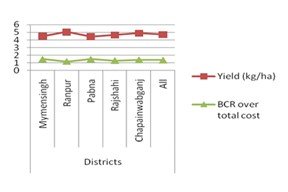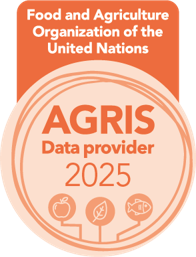Profitability and productivity of drought tolerant Aus rice variety Binadhan-19 in some areas of Bangladesh
https://doi.org/10.26832/24566632.2021.0604010
Abstract
The present study was conducted in five districts namely Mymensingh, Ranpur, Pabna, Rajshahi and Chapainwabganj in Bangladesh. The objectives of the study were i) to identify the socio-economic characteristics of Aus rice growers; ii) to estimate profitability and productivity of Binadhan-19 in the study areas; and iii) to find out the major preferences and constraints for the variety cultivation. A total of 200 farmers were randomly selected (40 from each location) to collect the data with a pre-designed questionnaire. The distribution of the farmers by age showed that the mean age for Binadhan-19 cultivated farmers was 43 years. In the study areas among the farmer 86% was educated. Farmers average experience was 20 year and income were Tk. 235066 (USD 2611.84) per year. Per hectare average yield of rice was 1.37 ton. It was estimated that, to produce one kilogram of rice, total cost incurred was Tk. 14 where per kg average selling price of rice was Tk. 17. The average gross return and gross margin of rice cultivation were found Tk. 90679 (USD 1007.54)/ha and Tk. 51290 (USD 559.88)/ha, respectively. Per hectare average net return was Tk. 2459 (USD 27.32) which was found to be highest in Chapainwabganj Tk. 29739 (USD 330.43) and lowest in Rangpur Tk. 12692 (USD 141.02) district. BCR on total cost basis was found 1.37. The highest preference was for neat rice 98% and the highest constrain said by the farmer was crop destroy by animal and bird of paddy for early ripening in Binadhan-19 cultivation.
Keywords:
Aus rice, Binadhan-19, Preferences and constraints, Profitability, ProductivityDownloads
References
BBS (Bangladesh Bureau of Statistics). (2019). Year Book of Statistics of Bangladesh. Ministry of Planning, Govt. of the Peoples’ Republic of Bangladesh. Dhaka Pp: xix
BBS (Bangladesh Bureau of Statistics). 45 Years Agriculture Statistics of Major Crops (Aus, Amon, Boro, Jute, Potato & Wheat). Bangladesh Bureau of Statistics. Ministry of Planning, Government of the People’s Republic of Bangladesh, Dhaka, Bangladesh. 2018.
Dillion, J. L., & Hardaker, J. B. (1993). Farm management research for small farmer development. FAO Publication, Rome, Italy.
Evenson, R. E., & Gollin, D., (2003a). Assessing the impact of the green revolution, 1960 to 2000. Science, 300 (5620), 758–762.
Evenson, R.E., Gollin, D., (2003b). Crop Variety Improvement and Its Effect on A. Kumar, et al. Land Use Policy 95 (2020) 104621 1
Gollin, D. (2010). Agricultural productivity and economic growth. Handbag, 4, 3825–3866.
Kabir, M. J., Gaydon, D. S., Cramb, R., & Roth, C. (2017), ‘Bioeconomic evaluation of cropping systems for saline coastal Bangladesh: I. Simulation under historical and future environments’, Submitted and in-review with Agricultural Systems.
Khatri-Chhetri, A., Pant, A., Aggarwal, P. K., Vasireddy, V. V., & Yadav, A. (2019). Stakeholders’ prioritization of climate-smart agriculture interventions: evaluation of a framework. Agricultural Systems, 174, 23–31.
Nwaobiala, C. U., & Adesope, O. M. (2013). Economic analysis of small holder rice production systems in Ebonyi State South East, Nigeria. Russian Journal of Agricultural and Socio-Economic Sciences, 23(11), 1-8.
Pereira, L.S., Oweis, T., & Zairi, A. (2002). Irrigation management under water scarcity. Agricultural Water Management, 57 (3), 175–206.
Pingali, P., & Rosengrant, M. W. (1994). Confronting the environmental consequences of the rice green revolution in Asia.
Rahman, M. S., Kabir, M. J., Sarkar, M. A. R., Islam, M. A. Rahman, M. C., & Siddique, M. A. B. (2020). Factors Affecting Adoption of BRRI Released Aus Rice varieties in Mymensingh District. Agricultural Economics, 5(5), 210-217.
Razia, Sultana, Md. Habibur Rahman, Mohammad Rashidul Haque, Md. Mohsin Ali Sarkar, & Syful Islam (2021). Determinants of Drought Tolerant Rice Variety Adoption: Evidence from Rural Farm Household in Northern Part of Bangladesh. Path of Science, 7 (10), 7005.
Sayeed, K. M., & Yunus, M. M. (2018). Rice prices and growth, and poverty reduction in Bangladesh. Food and Agriculture Organization of the United
Nations, Rome. 2018: 45
Susmita, D., Meisner, C., & Wheeler, D., (2007). Is environmentally friendly agriculture less profitable for farmers? Evidence on integrated pest management in Bangladesh. Review of Agricultural Economics, 29(1), 103–118.
Timsina, J., Wolf, J., Guilpart, N., van Bussel L.G.J., Grassini, P., & van Wart, J. (2018). Can Bangladesh produce enough cereals to meet future demand? Agricultural Systems, 163, 36–44.
United Nations (UN) (2014). The world population prospects, Key findings and advance tables. Department of Economics and Social Affairs, Population division, New York, USA.
World Bank, (2007). World Development Report 2008: Agriculture for Development. World Bank, Washington, DC.

Published
How to Cite
Issue
Section
Copyright (c) 2021 Agriculture and Environmental Science Academy

This work is licensed under a Creative Commons Attribution-NonCommercial 4.0 International License.

